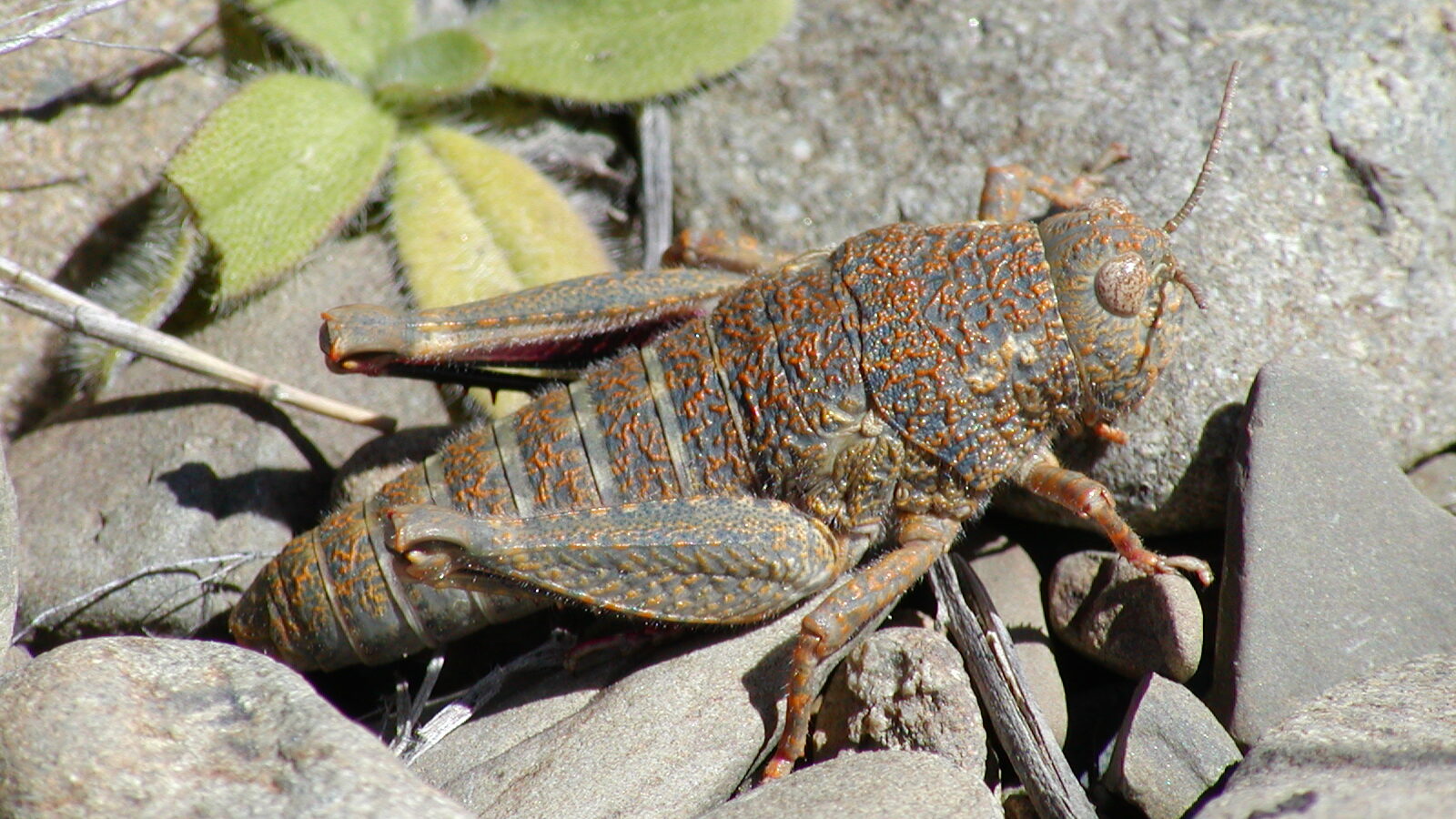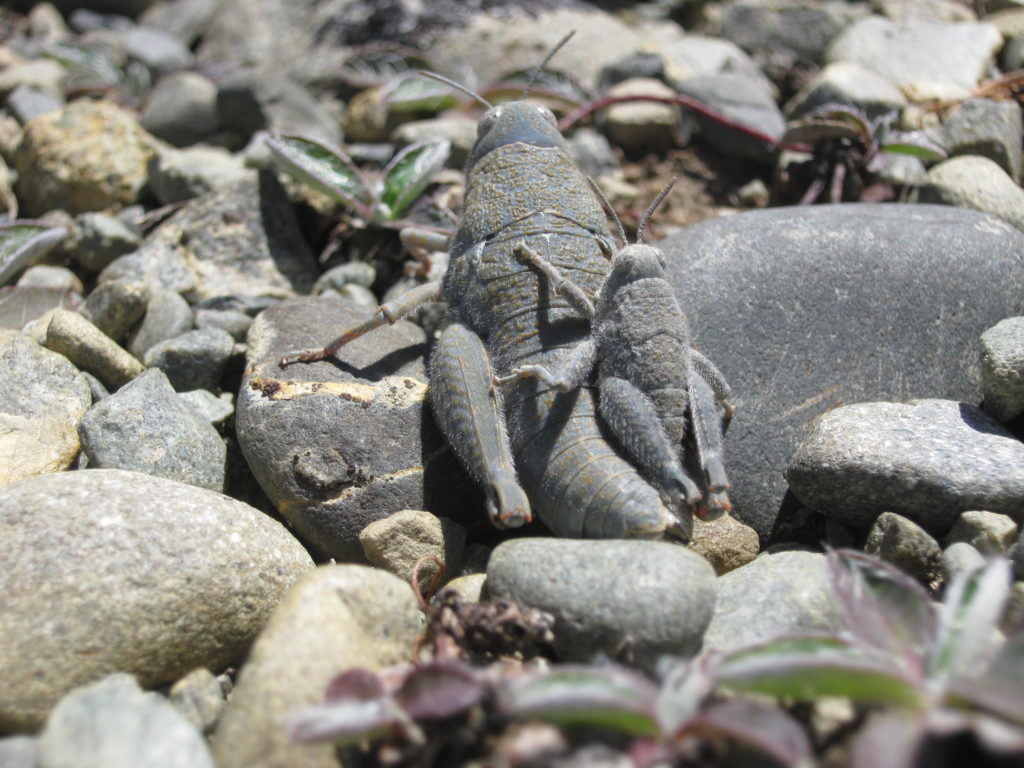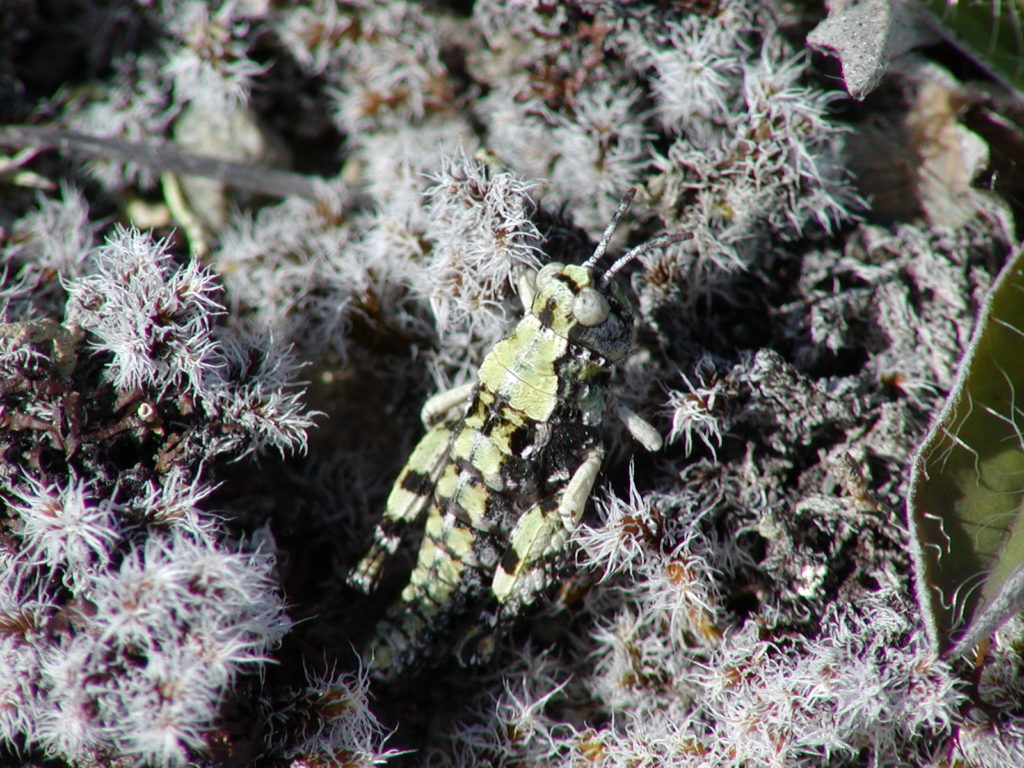Insects get eaten too. Scientists have reported that invertebrates have been found in 10-30% of cat guts and scats in the Mackenzie Basin, suggesting high country invertebrates, including some rare endemic grasshoppers, could be vulnerable to introduced mammal predators.

Christchurch-based researchers, Jennifer Schori, Richard Maloney, Tammy Steeves and Tara Murray investigate whether reducing mammal predators is beneficial to threatened and declining grasshoppers in the Mackenzie Basin in research published last year in the New Zealand Journal of Zoology.
“Grasshopper remains have also been found in cat scats both in the Mackenzie Basin and other parts of New Zealand. In years when cats’ main prey, rabbits, have experienced population crashes due to poisoning, the percentage of cat guts containing invertebrates increased to around 50%, suggesting a switch to smaller available prey.”
Even when rabbits are around, cats still eat insects as well, particularly in the Mackenzie.

“Even when rabbit prey are available, the percentage of cat guts containing invertebrates is still higher in the Mackenzie Basin than for other ecosystems in New Zealand; in other grassland regions between 5% and 10% of cat guts contain invertebrates, while in forests it is <1%. It is likely that kittens are a bigger threat to grasshoppers than adult cats as they are often too small to catch rabbits so must rely on smaller prey.”
Hedgehogs too are commonly found in the Mackenzie country and insects are their traditional food source.
“Hedgehogs are present in higher abundance than any other predatory mammal throughout the Mackenzie Basin and exhibit a diet comprised mostly of invertebrates. Scat analysis has shown grasshoppers and other orthoptera form a substantial component of the hedgehog diet in the Mackenzie Basin. Of concern is their ability to consume numerous invertebrates in a short space of time. Hedgehogs can exploit rich food patches by consuming large numbers of individuals in a single night. For Mackenzie Basin grasshoppers, which tend to have a patchy distribution and loose congregations, this behaviour is particularly threatening.”
Not all introduced predators are thought to pose an equal threat to Mackenzie grasshoppers. Rats and stoats are found in relatively low numbers in the Mackenzie and ferrets, while they will prey-switch to insects, are not believed to be major consumers of invertebrates. Cats and hedgehogs are therefore, the key predators of concern.
So what are the endemic grasshoppers that are at risk?
“Endemic to the South Island of New Zealand, Sigaus minutus (At Risk – Declining) is a small (males up to 10 mm, females up to 17 mm in body length), rugose grasshopper which is diversely coloured and visually cryptic. Currently, two populations of S. minutus exist in locations that receive predator control. The first population (Upper Ohau River) receives direct and high intensity mammalian predator control set up for the protection of black-fronted terns on a braided river island. The second population (Tekapo River) receives indirect predator control as a result of prey reduction in that the continuous suppression of rabbits to very low levels (<1 rabbit per kilometre) for more than a decade has likely resulted in significant reductions to populations of feral cats and ferrets at the site. As part of annual grasshopper surveys in the Mackenzie Basin, the Department of Conservation has monitored these two populations of S. minutus since 2007, along with a third (Lower Ohau River) in an area of no predator control.”
Brachaspis robustus is another Threatened – Nationally Endangered braided river grasshopper.
“It has many of the traits that make it susceptible to predation by introduced mammals. It is a large (males up to 17 mm and females up to 38 mm in body length), flightless and ground-dwelling insect which relies on visual crypsis when threatened. Body colour varies from shades of pale to dark grey through to reddish-brown allowing it to blend in with its habitat among riverbed gravels and silts. Endemic to the Mackenzie Basin, its range is severely restricted, and the few remaining populations are patchy in distribution and show trends of decline. Currently none of the few remaining natural populations of B. robustus receive any mammalian predator control.”
As with our native birds, some of the characteristics which make our grasshoppers different and special, now also make them particularly vulnerable to introduced predators.
“There are several traits seen in New Zealand invertebrates which are associated with vulnerability to predation by introduced mammals, and like other endemic fauna, a number of these traits have been attributed to lack of co-evolution with mammals. For example, many New Zealand invertebrate species exhibit a freeze response and rely on visual crypsis when threatened. This response provides an effective defense against predators that hunt by sight, such as the native birds and lizards with which many New Zealand invertebrate species co-evolved.”
Introduced mammal predators, are, however, more likely to detect prey by smell – so a freeze response by prey isn’t much use as a defence. It just makes prey an even easier catch.
“Other traits that make many New Zealand invertebrate species vulnerable to predation by introduced mammals include flightlessness, living on the ground, and gigantism. Large invertebrates are particularly vulnerable because they are often preferentially targeted by predatory mammals as a higher value food resource.”

The good news is the researchers found that even moderate predator control can make a difference.
“Long-term population trends of Sigaus minutus was investigated under three control regimes: high intensity, indirect control through prey reduction and no control. We then tested whether predator control benefits conservation management of Brachaspis robustus by translocating wild-caught individuals to areas of moderate versus no predator control.”
A significant positive trend in S. minutus counts occurred under high intensity and indirect control, suggesting that mammalian predator control is beneficial.
“Under high intensity predator control implemented at the Upper Ohau River site, S. minutus counts showed a significant positive trend over time. On average, counts increased by 10% per year. A similar trend was seen under the indirect predator control implemented at the Tekapo River site where counts increased significantly by an average of 4.5% each year. In contrast, at the Lower Ohau River site where no predator control was implemented, counts significantly decreased by 13% on average each year. Differences in the decline of translocated B. robustus were observed between moderate and no predator control release sites but could not be unequivocally attributed to predator densities.”
Meso-predator release is another factor that needs to be further investigated, the researchers believe.
“We recommend replicated predator control studies be undertaken to develop a predator management strategy which will enable grasshopper recovery and investigate the potential for meso-predator release and prey-switching under regimes that target specific mammals.”
The full research report is published in the New Zealand Journal of Zoology. Only the abstract is freely available online to non-subscribers, but public libraries may be able to provide full access.

